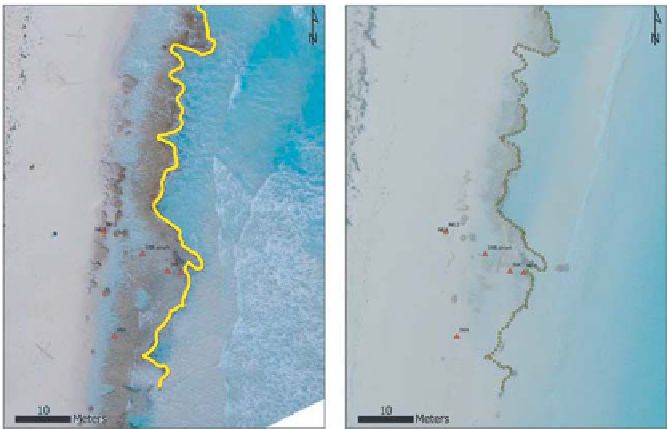Geology Reference
In-Depth Information
January 2005
July 2004
(a)
(b)
Fig. 5.
Aerial image of Site 6 in January
2005 compared to 6 months earlier,
July 2004, illustrating the signifi cant
change in sedimentation pattern and
burial. Geo-referenced yellow circles
defi ne the location of the outer reef
edge (linked by yellow line).
10 m
10 m
from holes in the reef fl at indicate that at least
the upper part of the outer reef fl at consists of cor-
alline limestone. The average height of sand burial
is clearly discernable in colour and texture on the
outer reef face: a thin veneer of microbial mat
and turf, brown in colour, covers the upper part,
whereas the lower part, if exposed, is a smooth
bare light grey limestone.
Prominent red to purple-coloured heads of the
branched coralline algae (
N. strictum
) line the
intricately shaped reef crest (Fig. 3f) (Steneck
et al.
, 1997). Due to its width, more energy of
breaking waves disseminates here before reaching
the back-reef lagoon, in comparison to the much
narrower reef to the north (Fig. 3a: Sites 1 and 2 in
comparison to Sites 3 and 4). Indeed, preliminary
data from wave-gauges confi rm ~40% less wave
energy here (Eckman, personal communication).
A few small encrusting brain corals are found on
the reef crest and numerous sea urchins inhabit
cavities and holes.
A ~25-m-wide reef fl at (Fig. 3c) comprises the
area between reef crest and lagoon, populated by
microbial mats, a variety of macroalgae (Littler
et al.
, 2005), rare small corals (Fig. 3d) and occa-
sional sponges. The most shoreward reef fl at and
edge facing the back-reef lagoon are covered with
centimetre-thick microbial mats.
Stromatolites in the back-reef lagoon develop
mainly as columnar structures (Fig. 6a and b),
sometimes coalescing together (Andres & Reid,
2006). With up to 40 cm in height and 50 cm diam-
eter, the stromatolite columns at Site 1 are the
largest in the Highborne Cay reef complex; height
and size decrease shoreward. Water depth in the
lagoon is dependent on the height of migrating
sand waves, with a maximum of 1 m of water depth
at low tide when the lagoon is devoid of sand.
There is no apparent preferred growth direction
with respect to incoming waves or longshore cur-
rent. Tops of stromatolites are often colonized by
macroalgae, dominantly
Batophora
and
Chondria
,
and to a minor extent
Acetabularia
(Andres &
Reid, 2006; Littler
et al.
, 2005). Furthermore,
clams, bivalves and gastropods are found in holes,
which they bored for shelter.
Discovery and dating of corals underlying
stromatolites
Detailed mapping and facies descriptions in this
and previous studies (Reid
et al.
, 1999; Andres &
Reid, 2006) have documented biological surface
cover for the Highborne Cay reef, as described
above (Fig. 4). To date, however, subsurface
information, stratigraphy and chronology have
been lacking. A recent discovery of a coral sur-
face underlying the stromatolites at Site 1 (Fig. 6)
prompted questions on the relationship between
underlying coral and overlying microbial build-
ups, the age of the reef and controlling factors
determining its evolution and development in
particular with respect to microbial versus meta-
zoan reef builders (i.e. scleractinian corals and
coralline algae). Information on the discovery and
dating of the basal coral surface and the dating
of a stromatolite head in the back-reef lagoon is
presented below.




